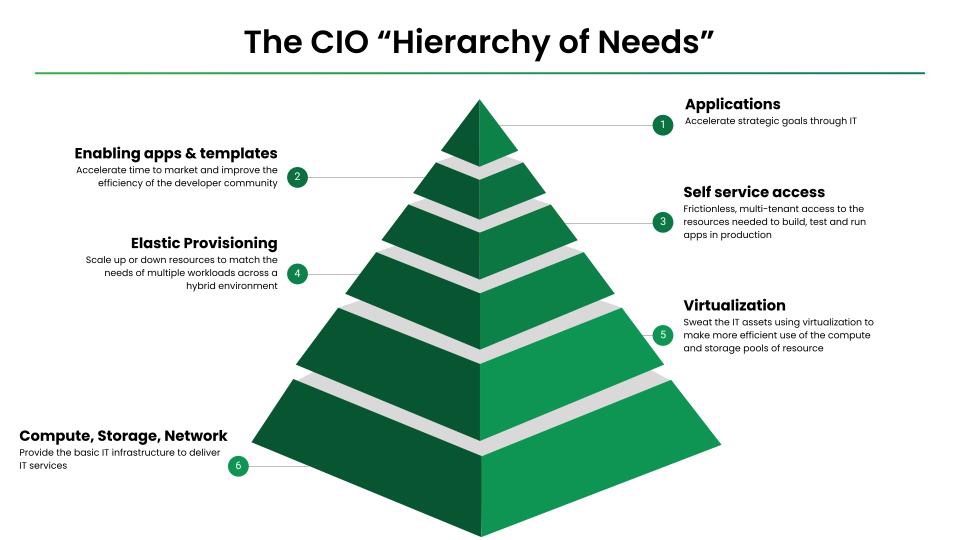Cloud can be a nebulous(!) and ill-defined term. It’s easy to identify when it’s delivered as a service by a hyperscaler, but what defines a cloud from other IT infrastructure when it’s in your own data centre?
In my previous post I broke down the concept of cloud into two parts - cloud the model, i.e. how applications are designed, and cloud the place i.e. where those applications reside. In this post I want to look at that second part of that in a bit more detail, especially in those instances where you want to build a private cloud in your own data centre or co-location facility, defining the key characteristics that, in my view, inform how you tell the difference between a true cloud, and just some legacy IT that’s been “cloud washed”.
A hierarchy of needs
A little while ago, and with more than a little inspiration from the work of Abraham Maslow, I developed a framework I called the “CIO Hierarchy of Needs”. At the time it was really just meant to be a device for myself and the SoftIron leadership team to think through where the pain points were for CIOs and how we might be able to uniquely address them. It turns out though, it’s a pretty handy way for also understanding why a cloud is a cloud and why, because of those qualities, CIOs find them so compelling.

Just like everybody’s base level need for food, water and clothing in Maslow’s model, so at the very basic level for a CIO they must provide that three legged stool of IT - compute, storage and network. Do nothing else and your teams can string those together and get something to work, however inefficiently. Add a layer of virtualisation above this, however, and now these resources can be unified. The individual silos of CPU and storage that were once inaccessible to the broader team become a single pool from which virtualised compute and storage environments can be drawn driving up utilisation.
Not content with this level of efficiency, in the next layer of the hierarchy the CIO seeks to to lock and unlock these resources as demand dictates - “elastically provisioning”, rather than reserving resources at the outset, to more dynamically and fully use all assets available, all of the time. In an ideal world for the CIO, that “piece of provisioning elastic” should be infinitely stretchy, never running out of resources while there’s a business need to provide more.
In the never-ending quest to create frictionless IT, our CIO might also then seek to get out of the way of their engineers completely, creating a self-service model that enables them to spin up the environments they need with no help from the ITOps team. Now, these “elastic” amounts of the right environment can be spun up or down in minutes, shortening time to value for new projects. Often related to the roll out of self service provisioning is the ability to deliver multi-tenancy. At this point, not only can fine grain controls be placed on individual tenants of the infrastructure, the actions and behaviours of individuals and the environments they spin up can be completely isolated from one another - improving resilience and performance for all. Better still for the CIO, this self service provisioning also provides a fantastic way to start to allocate the accurate costs of using the underlying resources in a granular way so that chargeback or showback can occur to justify further investment.
Already a pretty slick operation, CIOs could then further accelerate efficiency and time to value by providing, “off the shelf” templates and applications designed to make their engineer’s lives easier. These could be ready to run environments that can be spun up with the click of a mouse, right through to a full catalogue of applications and tools which the team might need - all delivered via a marketplace accessible behind that self service portal.
Of course the highest need of all for the CIO is to efficiently deliver the applications and IT capability that support the strategy of the organisation - and do so in a way that is super resilient, scalable and secure.
If you were a CIO looking to get all your needs met, is it any wonder so many turned to the public cloud to do that?
For reasons we discuss here though, not every application is a good fit in the public cloud. But CIOs can be a demanding bunch, and so projects to replicate all that goodness spring to life.
Approximating a cloud, or delivering the real deal?
It’s why cloud washing has become so rife in the industry. Traditional legacy technologies do well in the lower levels of the hierarchy of need (after all, that’s what they were designed for), but become increasingly challenged as you move up the stack. It’s why many private cloud projects seem to fail, or at the very least never quite get to those final upper levels of need that make the pain of knitting together all the hardware and software required to build the lower levels actually worthwhile.
It’s why, when you dig under the surface of many purported private cloud solutions there are limitations in just how big those infrastructures can grow, and just how elastic compute and storage resources can be independently scaled. And topics like true multi-tenancy, self service provisioning and application marketplaces tend to get skimmed over completely, and are rarely if ever actually delivered.
And let’s not forget, our CIOs needs are all bounded by efficiently delivering on budget, on time, and within the resources available to them. Infinite budgets to buy multiple vendor’s hardware, pay multiple vendor’s software licence and support fees, infinite teams of highly specialised engineering staff to architect, deploy and lifecycle manage the resulting infrastructure are more likely pipedream than bounded in reality.
HyperCloud delivers
To deliver a true private cloud you have to deliver both the model and the place.
Built, ground up, to do just that, HyperCloud delivers that public cloud experience, but in a package that can be efficiently deployed and run by the IT team you have, within the budgets you own. Virtualised compute, network and storage, independent, elastic scaling, self-service consumption, showback information, customisable application marketplace (or indeed, marketplaces) at your fingertips to deliver the templates and applications important to your business, all in a secure, elastic and resilient way.
When you really know what makes a cloud a cloud, and when you need your highest level needs met, there’s really very little choice.
To find out more, why not get in touch to arrange a chat.





